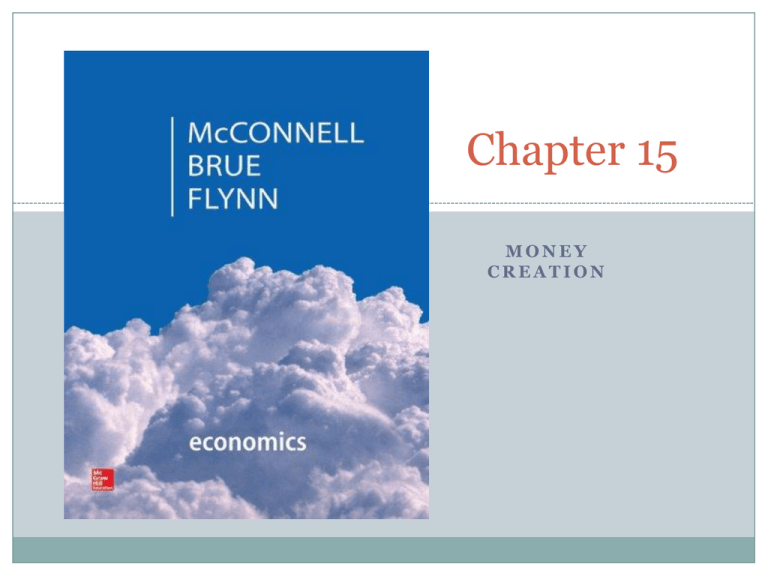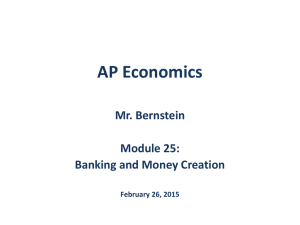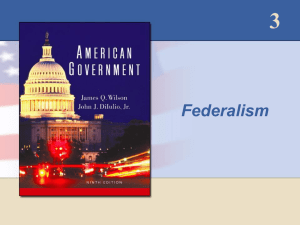
Chapter 15
MONEY
CREATION
Taylor Economics – Chapter 15
1. Bank panics:
a) occur frequently in fractional reserve banking
systems.
b) are a risk of fractional reserve banking, but are
unlikely when banks are highly regulated and
lend prudently.
c) cannot occur in a fractional reserve banking
system.
d) occur more frequently when the monetary system
is backed by gold.
Copyright © Houghton Mifflin Company. All rights
reserved.
Taylor Economics – Chapter 15
1. Bank panics:
a) occur frequently in fractional reserve banking
systems.
b) are a risk of fractional reserve banking,
but are unlikely when banks are highly
regulated and lend prudently.
c) cannot occur in a fractional reserve banking
system.
d) occur more frequently when the monetary system
is backed by gold.
Copyright © Houghton Mifflin Company. All rights
reserved.
Taylor Economics – Chapter 15
2. Other things equal, if the required reserve ratio
was lowered:
a) banks would have to reduce their lending.
b) the size of the monetary multiplier would
increase.
c) the actual reserves of banks would increase.
d) the Federal funds interest rate would rise.
Copyright © Houghton Mifflin Company. All rights
reserved.
Taylor Economics – Chapter 15
2. Other things equal, if the required reserve
ratio was lowered:
a) banks would have to reduce their lending.
b) the size of the monetary multiplier
would increase.
c) the actual reserves of banks would
increase.
d) the Federal funds interest rate would rise.
Copyright © Houghton Mifflin Company. All rights
reserved.
Taylor Economics – Chapter 15
3. A bank owns a 10-story office building. In the
bank's balance sheet, this would be an example of:
a) An asset
b) A liability
c) Capital stock
d) A checkable deposit
Copyright © Houghton Mifflin Company. All rights
reserved.
Taylor Economics – Chapter 15
3. A bank owns a 10-story office building. In the
bank's balance sheet, this would be an example of:
a) An asset
b) A liability
c) Capital stock
d) A checkable deposit
Copyright © Houghton Mifflin Company. All rights
reserved.
Taylor Economics – Chapter 15
4. What is one significant characteristic of fractional
reserve banking?
a) Banks are not subject to "panics" or "runs."
b) Banks use deposit insurance for loans to
customers
c) Bank loans will be equal to the amount of gold on
deposit
d) Banks can create money through lending their
reserves
Copyright © Houghton Mifflin Company. All rights
reserved.
Taylor Economics – Chapter 15
4. What is one significant characteristic of
fractional reserve banking?
a) Banks are not subject to "panics" or "runs."
b) Banks use deposit insurance for loans to
customers
c) Bank loans will be equal to the amount of gold
on deposit
d) Banks can create money through
lending their reserves
Copyright © Houghton Mifflin Company. All rights
reserved.
Taylor Economics – Chapter 15
5. A commercial bank has actual reserves of
$50,000 and checkable deposits of $200,000, and
the required reserve ratio is 20%. The excess
reserves of the bank are:
a) $10,000
b) $20,000
c) $40,000
d) $50,000
Copyright © Houghton Mifflin Company. All rights
reserved.
Taylor Economics – Chapter 15
5. A commercial bank has actual reserves
of $50,000 and checkable deposits of
$200,000, and the required reserve ratio is
20%. The excess reserves of the bank are:
a) $10,000
b) $20,000
c) $40,000
d) $50,000
Copyright © Houghton Mifflin Company. All rights
reserved.
Taylor Economics – Chapter 15
6. When a check is cleared against a bank, it will
lose:
a) Cash and securities
b) Checkable deposits and reserves
c) Reserves and capital stock
d) Loans and demand deposits
Copyright © Houghton Mifflin Company. All rights
reserved.
Taylor Economics – Chapter 15
6. When a check is cleared against a
bank, it will lose:
a) Cash and securities
b) Checkable deposits and reserves
c) Reserves and capital stock
d) Loans and demand deposits
Copyright © Houghton Mifflin Company. All rights
reserved.
Taylor Economics – Chapter 15
7. Assume that Johnson deposits $350 of
currency in his account in the XYZ bank.
Later the same day Swanson negotiates a
loan for $2,000 at the same bank. In what
direction and by what amounts has the
supply of money changed?
a) Increased by $2,350
b) Increased by $2,000
c) Decreased by $350
d) Decreased by $1,650
Copyright © Houghton Mifflin Company. All rights
reserved.
Taylor Economics – Chapter 15
7. Assume that Johnson deposits $350 of
currency in his account in the XYZ bank. Later
the same day Swanson negotiates a loan for
$2,000 at the same bank. In what direction and
by what amounts has the supply of money
changed?
a) Increased by $2,350
b) Increased by $2,000
c) Decreased by $350
d) Decreased by $1,650
Copyright © Houghton Mifflin Company. All rights
reserved.
Taylor Economics – Chapter 15
8. Maximum checkable-deposit expansion is equal
to:
a) Actual reserves minus excess reserves
b) Assets plus net worth and liabilities
c) Excess reserves times the monetary multiplier
d) Excess reserves divided by the monetary
multiplier
Copyright © Houghton Mifflin Company. All rights
reserved.
Taylor Economics – Chapter 15
8. Maximum checkable-deposit expansion is
equal to:
a) Actual reserves minus excess reserves
b) Assets plus net worth and liabilities
c) Excess reserves times the monetary
multiplier
d) Excess reserves divided by the monetary
multiplier
Copyright © Houghton Mifflin Company. All rights
reserved.
Taylor Economics – Chapter 15
9. Assume that the legally required reserve is 15
percent and commercial banks choose to hold
additional excess reserves equal to 5 percent of any
newly acquired deposits. Under these circumstances
the monetary multiplier for the commercial banking
system is:
a) 6.67
b) 5
c) 4
d) 3
Copyright © Houghton Mifflin Company. All rights
reserved.
Taylor Economics – Chapter 15
9. Assume that the legally required reserve is 15
percent and commercial banks choose to hold
additional excess reserves equal to 5 percent of
any newly acquired deposits. Under these
circumstances the monetary multiplier for the
commercial banking system is:
a) 6.67
b) 5
c) 4
d) 3
Copyright © Houghton Mifflin Company. All rights
reserved.
Taylor Economics – Chapter 15
10. A commercial bank has checkable deposit
liabilities of $400,000, reserves of $150,000, and a
required reserve ratio of 25%. The amount by which
a single commercial bank and the amount by which
the banking system can increase loans are,
respectively:
a) $50,000 and $100,000
b) $50,000 and $150,000
c) $50,000 and $200,000
d) $150,000 and $200,000
Copyright © Houghton Mifflin Company. All rights
reserved.
Taylor Economics – Chapter 15
10. A commercial bank has checkable deposit
liabilities of $400,000, reserves of $150,000,
and a required reserve ratio of 25%. The
amount by which a single commercial bank
and the amount by which the banking system
can increase loans are, respectively:
a) $50,000 and $100,000
b) $50,000 and $150,000
c) $50,000 and $200,000
d) $150,000 and $200,000
Copyright © Houghton Mifflin Company. All rights
reserved.







